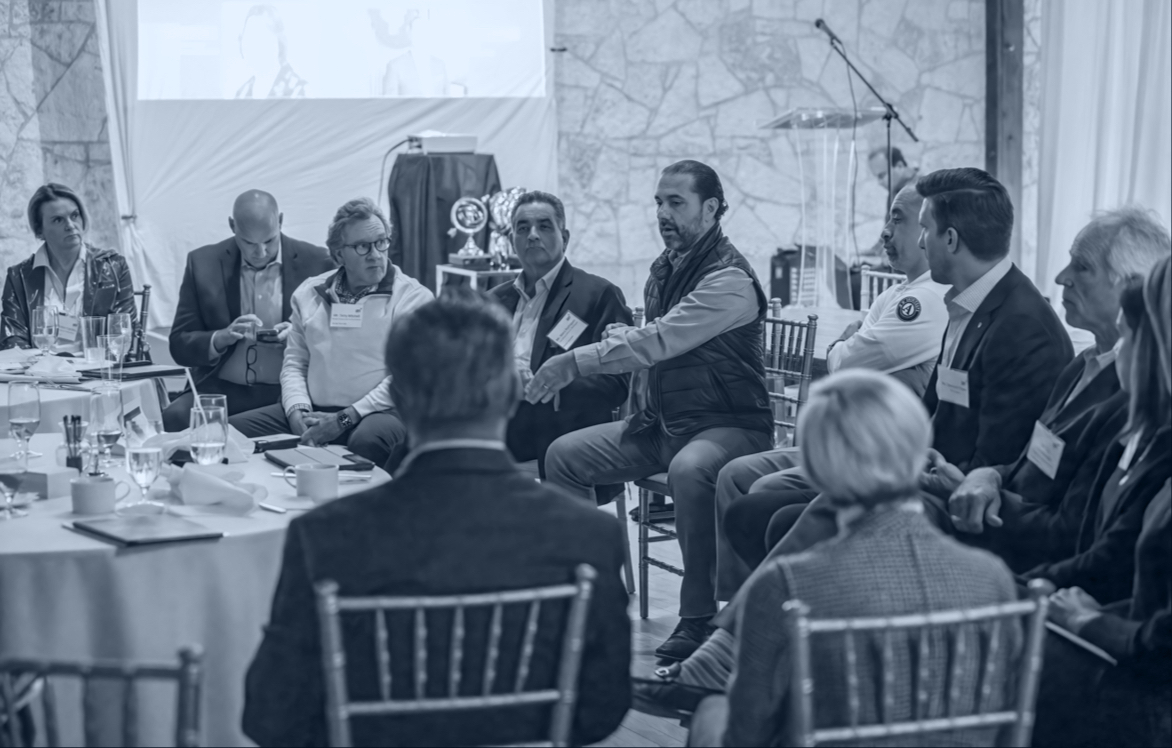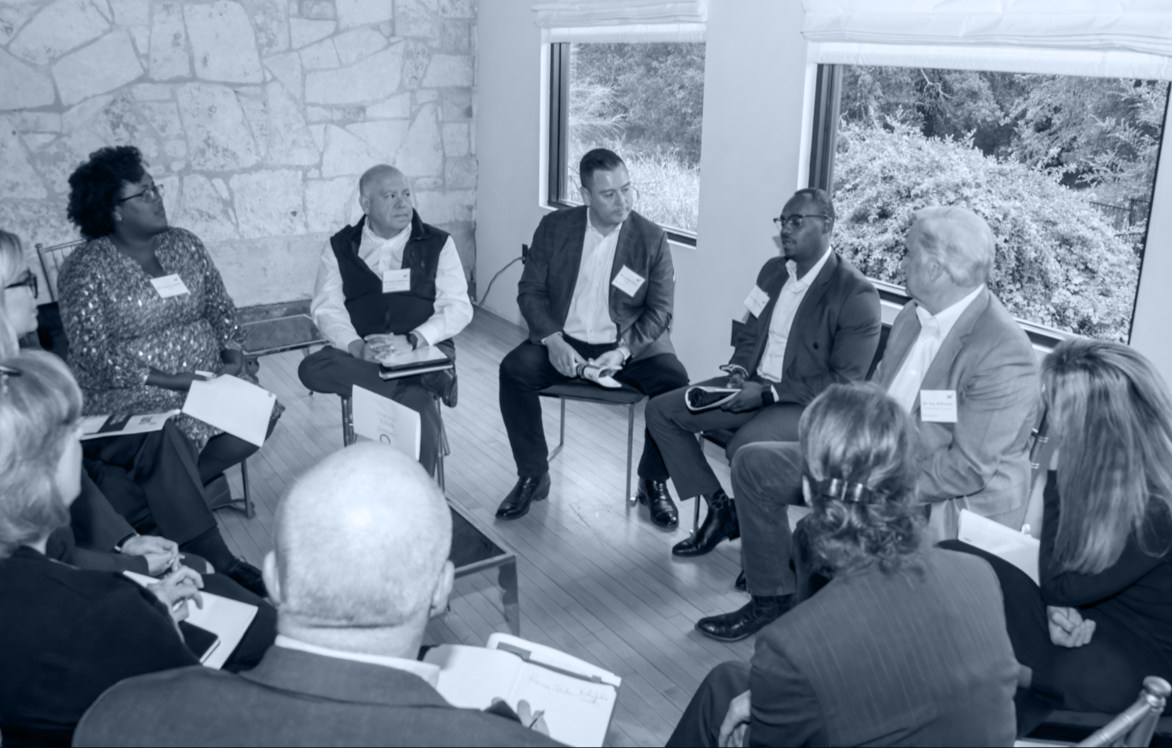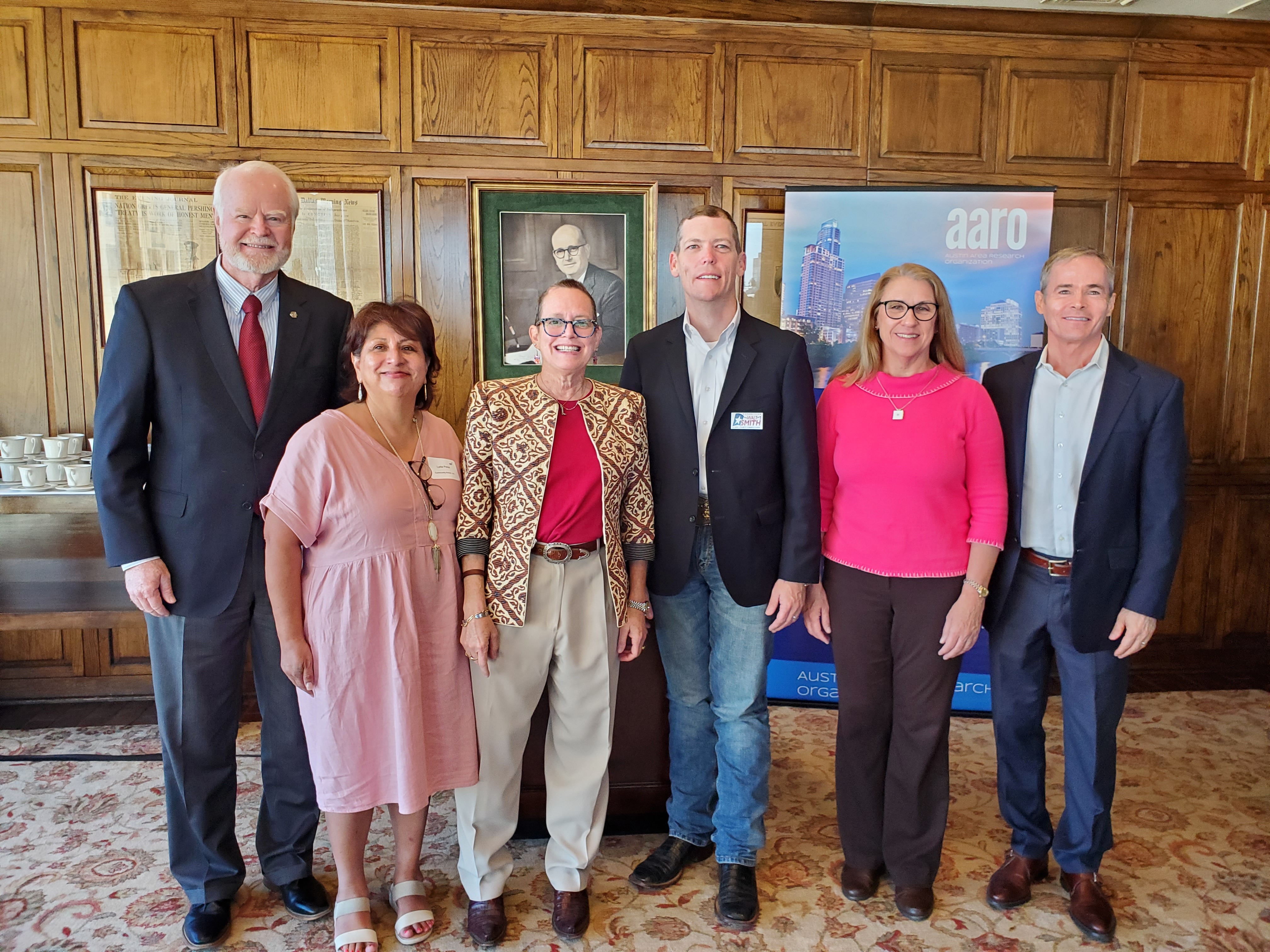About AARO
AARO takes a long-term, systemic view of the questions and issues shaping our region today. By asking big beautiful questions, we imagine, research, and test possibilities that can shape our region in positive ways for decades to come.
Our Approach
AARO engages the many spheres of influence, communities and jurisdictions of Central Texas to understand the interdependency of the issues in its research.
We are powered by round-table discussions among our thought leaders and by solid, thoughtful research into the thorniest of issues.
Membership is drawn from leaders throughout the region to bring diverse viewpoints to the table.
Our Priorities
AARO research leads the way to the future. Our focus areas of education, health, regional vision, social equity, transportation and water are just a starting point. Committees often see, and follow, an issue as it intersects with others while seeking regional threads of commonality to identify potential solutions.
-

Education
How do we help the Class of 2050 learn and prepare for their future?
-

Health
How can the region support better health outcomes for all Central Texans?
-

Social Equity
What are the systemic challenges driving housing unaffordability in Central Texans?
-

Transportation
How do we best enhance regional mobility through targeted investment in infrastructure and systems?
-

Water
How can AARO influence the long-term affordability, quality and accessibility of water for all Central Texans?
-

Regional Vision
What is the region’s shared strategic Vision for Central Texas through the year 2050?
AARO's Influence Timeline
2023
2022
2020
2018
2016
2014
2012
2010
2007
2006
2004
2001
1999
1997
1996
1994
1986
1981
1980
AARO Supports Creation of Texas Water Fund
The Texas Water Fund is a crucial mechanism to address water infrastructure challenges across all of Texas, Central Texas included. The November 2023 Constitutional Amendment to create the Texas Water Fund is an important step to unlock new capital for future improvements in water infrastructure projects, increase public awareness, adopt water conservation strategies, and support water loss mitigation projects.
The AARO membership strongly supports the creation, funding, goals, and objectives of the Texas Water fund and urges voters across the state to vote on amending the constitution on November 7th, 2023.
Read AARO's Statement of Support for Proposition 6
AARO and Business Leaders Study Mental Health in the Workplace
AARO convenes more than 100 regional business leaders to study Mental Health Myths, Facts and Workplace Solutions.
AARO Helps Increase Enrollment in Free Pre-K
AARO develops a framework to increase enrollment in free Pre-K for eligible students in Central Texas.
Related Research
AARO Helps Influence Establishment of Dell Medical School at UT Austin
AARO work to influence healthcare decision-makers and policy leaders over many years leads to the initiative that establishes the Dell Medical School at the University of Texas at Austin.
AARO Advocates for Career Expressways at ACC
AARO successfully advocates for the adoption of Career Expressways at Austin Community College.
AARO Research Helps Increase Affordable Housing Supply
AARO research leads the City of Austin to approve bonds and policy changes to increase its affordable housing supply.
Read full report
AARO Creates the McBee Fellowship
AARO creates the McBee Fellowship program to cultivate the civic interest of up-and-coming leaders throughout the region.
AARO Creates E3 Alliance
AARO creates and spins off the E3 Alliance, a regional, data-driven education collaborative working together to achieve lasting systemic change.
AARO Research Helps Create Central Health
AARO research leads to the creation of Central Health, the Travis County healthcare district to improve the health of the community by caring for those who need it most.
Regional Mobility Authority Comes to Texas
AARO support brings Regional Mobility Authorities, and subsequently the Central Texas Regional Mobility Authority, to life in the state of Texas.
50-Year Water Supply Deal Negotiated
AARO works to persuade LCRA and the City of Austin to negotiate a 50-year water supply deal.
AARO Supports Right-of-Way Acquisition
AARO publicly supports SH-130 toll way right-of-way acquisition.
AARO and Leadership Austin Join Causes
AARO and Leadership Austin join to run a public service preparation seminar open to prospective elected office candidates.
AARO Establishes Qualifications for AISD Trustees
AARO convenes 20 stakeholders to establish qualifications for AISD trustees.
AARO Helps Extend MoPac
AARO leads the advocacy work for approval of the northern and southern extensions of MoPac.
AARO Helps Launch ACC
AARO galvanizes business community support for passage of a 5-cent property tax to fund and launch Austin Community College independently of AISD.
The Inception of AARO
AARO is founded in 1980.
AARO Supports the Constitutional Amendment to Create the Texas Water Fund
The Austin Area Research Organization (AARO) urges voters to approve the constitutional amendment for the creation of the Texas Water Fund as a critical mechanism to increase water security in Central Texas and throughout the state.
Central Texas has a promising future characterized by a diverse community with ample opportunities for economic growth and a high quality of life for all its residents. As our region grows, with an estimated population of 3.9 million people by 2050, the establishment, expansion, and enhancement of water infrastructure become integral to achieving this vision.
Central Texas' water infrastructure, including pipes and distribution systems, requires continuous maintenance, upgrading, and replacement as they age, deteriorate, crack, and corrode. During times of drought and water scarcity, these systems are further strained, requiring logistical and financial resources for our region's water utilities. This is particularly difficult for rural areas with smaller tax bases which often lack the funding necessary to improve their water infrastructure, leading to a disproportionate number of boil-water notices.
According to the 7th Drinking Water Infrastructure Needs Survey and Assessment conducted by the Environmental Protection Agency, Texas' drinking water infrastructure needs an investment of more than $61 billion over the next 20 years. As it stands, the state loses an estimated 131 billion gallons of water a year to leaking water main pipes and is short of 6.9-million-acre-feet of supply to meet expected demands in the next 50 years.
The Texas Water Fund is a crucial mechanism to address these water infrastructure challenges.
The fund would provide financial assistance for developing new water supplies, fixing deteriorating water systems, and implementing water conservation and loss mitigation projects. Upon approval of the constitutional amendment, the Texas Water Fund would allocate $250 million to the New Water Supply Fund designed desalination, oil and gas produced water treatment projects, and aquifer storage and recovery projects. It would also support water infrastructure projects prioritized by risk or need, projects for rural political subdivisions and municipalities with populations of less than 150,000, projects with completed state or federal permitting, the statewide water public awareness program, water conservation strategies, and water loss mitigation projects.
This constitutional amendment will unlock capital for future improvements in water infrastructure projects, increase public awareness, adopt water conservation strategies, and support water loss mitigation projects.
The AARO membership strongly supports the creation, funding, goals, and objectives of the Texas Water fund and urges voters across the state to say yes to amending the constitution on November 7th, 2023.
Close
AARO Supports Proposition A: An Investment in Transit-at-Scale Through Project Connect
The Austin Area Research Organization (AARO) urges voters to approve the City of Austin’s Proposition A to support implementation of the 2020 Project Connect System Plan.
Central Texas will continue to be an attractive place to live, work, play and visit in the post-pandemic world. The regional population is projected to reach 4.7 million people by 2045, traversing the region in ways we can only imagine. While an increasing number of these people will be able to work from home, the vast majority will need to leave home for work or school. Ride sharing services, buses in managed lanes and planning for proximity between jobs and housing can all help, but the sheer volume of people moving into, and commuting daily through, the region requires transit-at-scale –– an integrated system of rail and high capacity bus lines –– to make our transportation system work.
The 2020 Project Connect System Plan (Project Connect) represents a wise investment in transit-at-scale. It is a well-crafted system with layers of service types appropriate to current and anticipated ridership density in each corridor. It establishes a strong baseline for a regional system over time and, with the planned downtown transit tunnel and terminal, it will accommodate long-term growth in population and ridership as well as expansion locally and regionally as surrounding communities connect to the system.
Project Connect will result in historically underserved parts of our community receiving better transit service and enhanced connectivity to essential city services, dozens of educational facilities, hundreds of thousands of jobs, many health clinics and hospitals and more than 30,000 affordable housing units. Proposition A includes $300 million for anti-displacement strategies in the Project Connect corridors, including Equitable Transit Oriented Development, and additional commitments from
Austin. The Austin Transit the city of Austin to identify, monitor and work to mitigate disparate impacts. This is perhaps the first major urban transit plan anywhere in the nation that dedicates funds on such a large-scale address nearby displacement from the very beginning.
Capital Metro currently serves tens of thousands of essential workers daily. During the initial and most strict shutdown period of the pandemic, daily ridership averaged 38,500 – comprising essential workers such as nurses, grocery store clerks, cooks and others. As more people have returned to work, ridership has also increased. While many people are working from home successfully now, many more are unemployed, ill-suited to working from home every day or in jobs that require in-person interactions. We have already seen a return to some levels of light congestion as people begin returning to work and recognize that now is an opportune time to make a transformational investment in transit that will support our economic recovery and enhance the region’s resiliency. When Project Connect is constructed as planned, it will provide over 280,000 trips for Central Texans daily – more than double Capital Metro’s average daily ridership in January 2020 and significantly more than the 175,000 daily trips on IH-35 across Lady Bird Lake.
The economic impact to the region of such an investment will be significant. It has been estimated that federal funds could match nearly dollar-for-dollar the funds invested locally and, for every cumulative $1 billion invested, nearly 10,000 jobs and $1.38 billion in economic activity will be generated over the life of the system buildout. The long-term benefit to the region will be felt in time and cost savings for commuters, productivity and recruitment success for employers, increased density along transit corridors, a more efficient international airport, a safer mobility alternative to automobiles and a lower carbon footprint as Capital Metro transitions away from diesel-powered vehicles.
Financing the City’s investment in Project Connect with a tax rate election is also sound public policy. Doing so ensures greater transparency with respect to the cost of the system to taxpayers, provides a permanent source of operating funds, reduces financing costs by providing a revenue source for initial expenditures and provides flexibility to maximize federal matching funds and leverage private investments.
This investment is unprecedented, as is the partnership between Capital Metro and the City of Partnership oversight board will provide transparency and accountability for the construction and operation of the projects. It should serve as a model and a framework for the future participation of regional communities in a truly regional transportation system to meet our future needs.
AARO envisions Central Texas as an exemplary region: dynamic, thriving and sustainable for all. Accordingly, AARO has long advocated for mobility infrastructure and recently pledged to do more to end institutional racism and systemic inequities – investing in Project Connect is an important step toward that vision.
Like Austin did when it approved the creation of ACC and Central Health, it is time for our community to once again step up and agree to a generational investment in a sophisticated high-capacity transit system anchored in the core of the region with plans to develop future regional connections as land use, density and population warrant. Project Connect is a worthy investment to that end.
Close
The Austin Area Research Organization (AARO) urges voters to approve the City of Austin's Proposition A to support implementation of the 2020 Project Connect System Plan.
Central Texas will continue to be an attractive place to live, work, play and visit in the post-pandemic world. The regional population is projected to reach 4.7 million people by 2045, traversing the region in ways we can only imagine. While an increasing number of these people will be able to work from home, the vast majority will need to leave home for work or school. Ride sharing services, buses in managed lanes and planning for proximity between jobs and housing can all help, but the sheer volume of people moving into, and commuting daily through, the region requires transit-at-scale - an integrated system of rail and high capacity bus lines - to make our transportation system work.
The 2020 Project Connect System Plan (Project Connect) represents a wise investment in transit-at-scale. It is a well-crafted system with layers of service types appropriate to current and anticipated ridership density in each corridor. It establishes a strong baseline for a regional system over time and, with the planned downtown transit tunnel and terminal, it will accommodate long-term growth in population and ridership as well as expansion locally and regionally as surrounding communities connect to the system.
Project Connect will result in historically underserved parts of our community receiving better transit service and enhanced connectivity to essential city services, dozens of educational facilities, hundreds of thousands of jobs, many health clinics and hospitals and more than 30,000 affordable housing units. Proposition A includes $300 million for anti-displacement strategies in Project Connect corridors, including Equitable Transit Oriented Development, and additional commitments from the city of Austin to identify, monitor and work to mitigate disparate impacts. This is perhaps the first major urban transit plan anywhere in the nation that dedicates funds on such a large-scale address nearby displacement from the very beginning.
Capital Metro currently serves tens of thousands of essential workers daily. During the initial and most strict shutdown period of the pandemic, daily ridership averaged 38.500 — compromising essential workers such as nurses, grocery store clerks, cooks and others. As more people have returned to work, ridership has also increased. While many people are working from home successfully now, many more are unemployed, ill-suited to working from home every day or in jobs that require in-person interactions. We have already seen a return to some levels of light congestion as people begin returning to work and recognize that now is an opportune time to make a transformational investment in transit that will support our economic recovery and enhance the region's resiliency. When Project Connect is constructed as planned, it will provide over 280,000 trips for Central Texans daily — more than double Capital Metro's average daily ridership in January 2020 and significantly more than the 175,000 daily trips on IH-35 across Lady Bird Lake.
Close
Vision, Mission, and Shared Values
AARO envisions Central Texas as an exemplary region: dynamic, thriving and sustainable for all.
Through thoughtful, deliberative dialogue and study, our mission is to engage committed leaders in advancing regional solutions to benefit the long-term economic and social well-being of Central Texas.
Our Values
AARO Members:
-
 Act as stewards for the greater common good
Act as stewards for the greater common good
-
 Lead with integrity – individually and collectively
Lead with integrity – individually and collectively
-
 Establish and nurture relationships
Establish and nurture relationships
-
 Think and act systemically, considering the interdependency of issues
Think and act systemically, considering the interdependency of issues
-
 Engage in collaborative efforts that honor the wisdom inside and outside of AARO
Engage in collaborative efforts that honor the wisdom inside and outside of AARO
We strive to be:
-
Knowledgeable
-
Inclusive
-
Bold
-
Humble
-
Courageous
-
Open-minded
-
Thoughtful
-
Fair
AARO Race Equity Pledge
- We will not run from the uncomfortable conversations. In fact, we will become comfortable being uncomfortable.
- We will honor, believe and elevate those with lived experience with racism and inequities.
- We will seek out, support and engage organizations that promote social justice and racial equity across our priority areas.
- We will stand up, speak up and act up when we see injustice.
- We will review the recommendations of the Mayor’s Task Force on Institutional Racism and Systemic Inequities and other sources relating to our priority areas.
- We will shift from shaking our heads in disbelief, to lifting our voices in opposition.
- We will shift from avoiding racism to confronting it.
- We will shift from simply being non-racist to being anti-racist.
AARO's Armillary
An armillary is a celestial framework. It is included in AARO’s identity to remind us to:
Set our sights on the horizon.
Use science and data to light the way.
Work in close orbit with one another to identify solutions to the region’s challenges.








